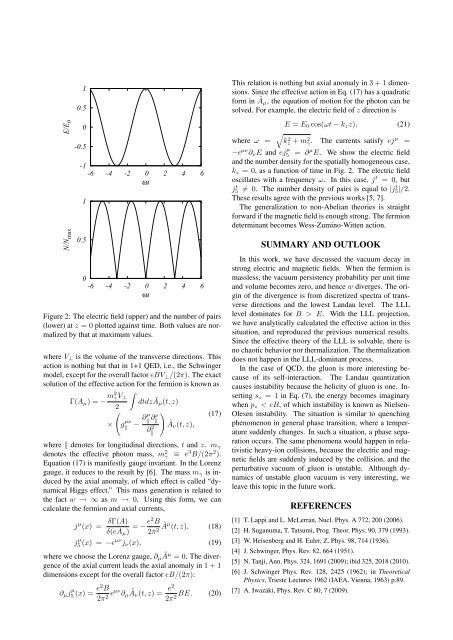Proceedings of International Conference on Physics in ... - KEK
Proceedings of International Conference on Physics in ... - KEK
Proceedings of International Conference on Physics in ... - KEK
You also want an ePaper? Increase the reach of your titles
YUMPU automatically turns print PDFs into web optimized ePapers that Google loves.
E/E 0<br />
N/N max<br />
1<br />
0.5<br />
0<br />
-0.5<br />
-1<br />
-6 -4 -2 0<br />
ωt<br />
2 4 6<br />
1<br />
0.5<br />
0<br />
-6 -4 -2 0<br />
ωt<br />
2 4 6<br />
Figure 2: The electric field (upper) and the number <str<strong>on</strong>g>of</str<strong>on</strong>g> pairs<br />
(lower) at z = 0 plotted aga<strong>in</strong>st time. Both values are normalized<br />
by that at maximum values.<br />
where V⊥ is the volume <str<strong>on</strong>g>of</str<strong>on</strong>g> the transverse directi<strong>on</strong>s. This<br />
acti<strong>on</strong> is noth<strong>in</strong>g but that <strong>in</strong> 1+1 QED, i.e., the Schw<strong>in</strong>ger<br />
model, except for the overall factor eBV⊥/(2π). The exact<br />
soluti<strong>on</strong> <str<strong>on</strong>g>of</str<strong>on</strong>g> the effective acti<strong>on</strong> for the fermi<strong>on</strong> is known as<br />
Γ(Aµ) = − m2 ∫<br />
γV⊥<br />
dtdz<br />
2<br />
õ(t, z)<br />
×<br />
(<br />
g µν<br />
<br />
− ∂µ<br />
∂ν <br />
∂ 2 <br />
)<br />
Ãν(t, z),<br />
(17)<br />
where denotes for l<strong>on</strong>gitud<strong>in</strong>al directi<strong>on</strong>s, t and z. mγ<br />
denotes the effective phot<strong>on</strong> mass, m 2 γ ≡ e 3 B/(2π 2 ).<br />
Equati<strong>on</strong> (17) is manifestly gauge <strong>in</strong>variant. In the Lorenz<br />
gauge, it reduces to the result by [6]. The mass mγ is <strong>in</strong>duced<br />
by the axial anomaly, <str<strong>on</strong>g>of</str<strong>on</strong>g> which effect is called “dynamical<br />
Higgs effect.” This mass generati<strong>on</strong> is related to<br />
the fact w → ∞ as m → 0. Us<strong>in</strong>g this form, we can<br />
calculate the fermi<strong>on</strong> and axial currents,<br />
j µ (x) = δΓ(A)<br />
δ(eAµ) = −e2 B<br />
2π 2 õ (t, z), (18)<br />
j µ<br />
5 (x) = −ɛµν jν(x), (19)<br />
where we choose the Lorenz gauge, ∂µ õ = 0. The divergence<br />
<str<strong>on</strong>g>of</str<strong>on</strong>g> the axial current leads the axial anomaly <strong>in</strong> 1 + 1<br />
dimensi<strong>on</strong>s except for the overall factor eB/(2π):<br />
∂µj µ<br />
5 (x) = e2 B<br />
2π2 ɛµν∂µ Ãν(t, z) = e2<br />
BE. (20)<br />
2π2 This relati<strong>on</strong> is noth<strong>in</strong>g but axial anomaly <strong>in</strong> 3 + 1 dimensi<strong>on</strong>s.<br />
S<strong>in</strong>ce the effective acti<strong>on</strong> <strong>in</strong> Eq. (17) has a quadratic<br />
form <strong>in</strong> õ, the equati<strong>on</strong> <str<strong>on</strong>g>of</str<strong>on</strong>g> moti<strong>on</strong> for the phot<strong>on</strong> can be<br />
solved. For example, the electric field <str<strong>on</strong>g>of</str<strong>on</strong>g> z directi<strong>on</strong> is<br />
E = E0 cos(ωt − kzz), (21)<br />
where ω =<br />
√<br />
k2 z + m2 γ. The currents satisfy ej µ =<br />
−ɛ µν∂νE and ej µ<br />
5 = ∂µ E. We show the electric field<br />
and the number density for the spatially homogeneous case,<br />
kz = 0, as a functi<strong>on</strong> <str<strong>on</strong>g>of</str<strong>on</strong>g> time <strong>in</strong> Fig. 2. The electric field<br />
oscillates with a frequency ω. In this case, jt = 0, but<br />
jt 5 = 0. The number density <str<strong>on</strong>g>of</str<strong>on</strong>g> pairs is equal to |jt 5|/2.<br />
These results agree with the previous works [5, 7].<br />
The generalizati<strong>on</strong> to n<strong>on</strong>-Abelian theories is straight<br />
forward if the magnetic field is enough str<strong>on</strong>g. The fermi<strong>on</strong><br />
determ<strong>in</strong>ant becomes Wess-Zum<strong>in</strong>o-Witten acti<strong>on</strong>.<br />
SUMMARY AND OUTLOOK<br />
In this work, we have discussed the vacuum decay <strong>in</strong><br />
str<strong>on</strong>g electric and magnetic fields. When the fermi<strong>on</strong> is<br />
massless, the vacuum persistency probability per unit time<br />
and volume becomes zero, and hence w diverges. The orig<strong>in</strong><br />
<str<strong>on</strong>g>of</str<strong>on</strong>g> the divergence is from discretized spectra <str<strong>on</strong>g>of</str<strong>on</strong>g> transverse<br />
directi<strong>on</strong>s and the lowest Landau level. The LLL<br />
level dom<strong>in</strong>ates for B > E. With the LLL projecti<strong>on</strong>,<br />
we have analytically calculated the effective acti<strong>on</strong> <strong>in</strong> this<br />
situati<strong>on</strong>, and reproduced the previous numerical results.<br />
S<strong>in</strong>ce the effective theory <str<strong>on</strong>g>of</str<strong>on</strong>g> the LLL is solvable, there is<br />
no chaotic behavior nor thermalizati<strong>on</strong>. The thermalizati<strong>on</strong><br />
does not happen <strong>in</strong> the LLL-dom<strong>in</strong>ant process.<br />
In the case <str<strong>on</strong>g>of</str<strong>on</strong>g> QCD, the glu<strong>on</strong> is more <strong>in</strong>terest<strong>in</strong>g because<br />
<str<strong>on</strong>g>of</str<strong>on</strong>g> its self-<strong>in</strong>teracti<strong>on</strong>. The Landau quantizati<strong>on</strong><br />
causes <strong>in</strong>stability because the helicity <str<strong>on</strong>g>of</str<strong>on</strong>g> glu<strong>on</strong> is <strong>on</strong>e. Insert<strong>in</strong>g<br />
sz = 1 <strong>in</strong> Eq. (7), the energy becomes imag<strong>in</strong>ary<br />
when pz < eB, <str<strong>on</strong>g>of</str<strong>on</strong>g> which <strong>in</strong>stability is known as Nielsen-<br />
Olesen <strong>in</strong>stability. The situati<strong>on</strong> is similar to quench<strong>in</strong>g<br />
phenomen<strong>on</strong> <strong>in</strong> general phase transiti<strong>on</strong>, where a temperature<br />
suddenly changes. In such a situati<strong>on</strong>, a phase separati<strong>on</strong><br />
occurs. The same phenomena would happen <strong>in</strong> relativistic<br />
heavy-i<strong>on</strong> collisi<strong>on</strong>s, because the electric and magnetic<br />
fields are suddenly <strong>in</strong>duced by the collisi<strong>on</strong>, and the<br />
perturbative vacuum <str<strong>on</strong>g>of</str<strong>on</strong>g> glu<strong>on</strong> is unstable. Although dynamics<br />
<str<strong>on</strong>g>of</str<strong>on</strong>g> unstable glu<strong>on</strong> vacuum is very <strong>in</strong>terest<strong>in</strong>g, we<br />
leave this topic <strong>in</strong> the future work.<br />
REFERENCES<br />
[1] T. Lappi and L. McLerran, Nucl. Phys. A 772, 200 (2006).<br />
[2] H. Suganuma, T. Tatsumi, Prog. Theor. Phys. 90, 379 (1993).<br />
[3] W. Heisenberg and H. Euler, Z. Phys. 98, 714 (1936).<br />
[4] J. Schw<strong>in</strong>ger, Phys. Rev. 82, 664 (1951).<br />
[5] N. Tanji, Ann. Phys. 324, 1691 (2009); ibid 325, 2018 (2010).<br />
[6] J. Schw<strong>in</strong>ger Phys. Rev. 128, 2425 (1962); <strong>in</strong> Theoretical<br />
<strong>Physics</strong>, Trieste Lectures 1962 (IAEA, Vienna, 1963) p.89.<br />
[7] A. Iwazaki, Phys. Rev. C 80, 7 (2009).













